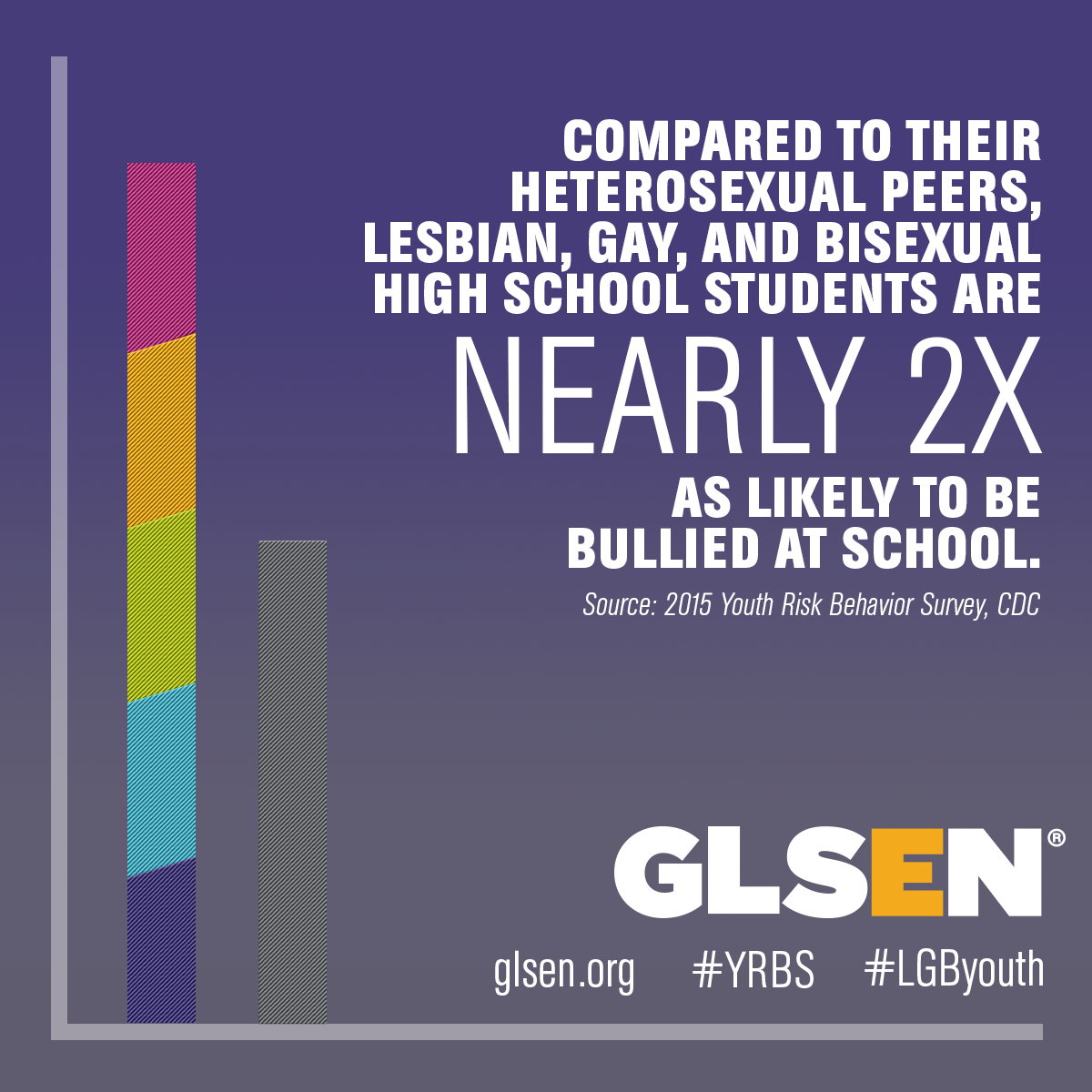This is a guest post by Laura Kann, PhD, Chief of the School-Based Surveillance Branch of the Division of Adolescent and School Health, Centers for Disease Control and Prevention.
The first nationally representative study of U.S. lesbian, gay, and bisexual high school students finds that lesbian, gay, and bisexual students experience substantially higher levels of physical and sexual violence and bullying than other students.
The report, Sexual Identity, Sex of Sexual Contacts, and Health-Related Behaviors Among Students in Grades 9-12 – United States and Selected Sites, 2015, found that these students are significantly more likely to report:
- Being physically forced to have sexual intercourse (18 percent lesbian/gay/bisexual vs. 5 percent heterosexual
- Experiencing sexual dating violence (23 percent lesbian/gay/bisexual vs. 9 percent heterosexual)
- Experiencing physical dating violence (18 percent lesbian/gay/bisexual vs. 8 percent heterosexual)
- Being bullied at school or online (at school: 34 percent lesbian/gay/bisexual vs. 19 percent heterosexual; online: 28 percent lesbian/gay/bisexual vs. 14 percent heterosexual)

Published in CDC’s Morbidity and Mortality Weekly Report (MMWR), the report examines the prevalence of more than 100 health behaviors among lesbian, gay, and bisexual students to the prevalence of these behaviors among heterosexual students. These analyses are possible due to the inclusion of two new questions about sex of sexual contacts and sexual identity on the 2015 National Youth Risk Behavior Survey (YRBS). The YRBS is the nation’s principal source of data for tracking national health risk behaviors among high school students.
These findings confirm substantial disparities in violence-related and other health outcomes among students who identify as lesbian, gay, and bisexual. While smaller studies have shown similar disparities, this study documents the national scope of the problem and opens the door to the type of analyses, research, and programs needed to make progress in protecting the health of the country’s young people.
Dangerous intersection of risks place lesbian, gay, and bisexual youth at high risk for suicide and other severe outcomes
While physical and sexual violence and bullying are serious health dangers on their own, a combination of complex factors can place young people at high risk for suicide, depression, addiction, poor academic performance, and other severe consequences.
The YRBS data show lesbian, gay and bisexual students are at substantial risk for several of these serious outcomes:
- More than 40 percent of lesbian, gay, and bisexual students have seriously considered suicide, and 29 percent reported having attempted suicide during the past 12 months.
- Sixty percent of lesbian, gay, and bisexual students reported having been so sad or hopeless they stopped doing some of their usual activities.
- Lesbian, gay, and bisexual students are up to five times more likely than other students to report using illegal drugs.
- More than one in 10 lesbian, gay, and bisexual students reported missing school during the past 30 days due to safety concerns. While not a direct measure of school performance, absenteeism has been linked to low graduation rates, which can have lifelong consequences.
Parents, schools, and communities can serve as sources of strength
Research suggests that comprehensive, community-wide prevention efforts can reduce the risk of multiple types of violence for these and other vulnerable youth. Studies suggest that parents can play a role in fostering resiliency by providing strong family support and teaching all adolescents non-violent problem-solving skills. Schools can also build an environment that provides a sense of safety and connection for all students, including lesbian, gay, and bisexual youth.
CDC works with communities, schools, and partners across the nation to expand programs and support data collection and research on the most effective approaches to prevent sexual, dating, and other types of violence and provide the support needed to protect victims from suicide and other severe consequences. Among key efforts, CDC is working to expand available data on suicide, to provide resources and support to schools in violence and bullying prevention, and to evaluate numerous community-level programs to prevent youth violence. The Youth Risk Behavior Surveillance System is one of several key CDC surveillance systems collecting health-related data on lesbian, gay, and bisexual individuals.
The report, in CDC’s Morbidity and Mortality Weekly Report (MMWR), examines the prevalence of more than 100 health behaviors among lesbian, gay, and bisexual students to the prevalence of these behaviors among heterosexual students. These analyses are possible due to the inclusion of two new questions about sex of sexual contacts and sexual identity on the 2015 National Youth Risk Behavior Survey (YRBS). The YRBS is the nation’s principal source of data for tracking national health risk behaviors among high school students.
The 2015 YRBS data are available at www.cdc.gov/yrbs.
Laura Kann, PhD, is Chief of the School-Based Surveillance Branch of the Division of Adolescent and School Health, Centers for Disease Control and Prevention. She is the lead author of the report.

